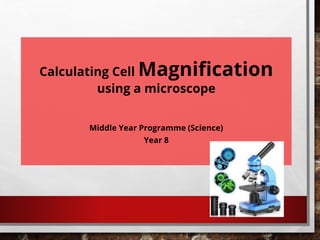
Microscope and Cell Magnification.pptx
- 1. Calculating Cell Magnification using a microscope Middle Year Programme (Science) Year 8
- 2. • To label the parts of a microscope. • To safely use a microscope to magnify objects. • To make scientific drawings of objects under the microscope. • To learn how to calculate cell magnification Learning Objectives
- 3. Put the following objects in order of size. You can use your device to research their size. bacteria red blood cell DNA paperclip grain of salt Extension: Which of these objects can only be seen using a microscope?
- 4. bacteria red blood cell DNA paperclip grain of salt Extension: Which of these objects can only be seen using a microscope? increasing size bacteria, red blood cell and DNA
- 5. MICROSCOPES • MICROSCOPES HAVE BEEN USED FOR MANY YEARS TO OBSERVE OBJECTS THAT ARE TOO SMALL TO SEE WITH THE NAKED EYE. THE FIRST MICROSCOPE WAS INVENTED IN THE 1500S. • OVER TIME, THE MAGNIFICATION AND RESOLUTION OF MICROSCOPES HAS SIGNIFICANTLY IMPROVED DUE TO DEVELOPMENTS IN TECHNOLOGY. WE NOW HAVE MICROSCOPES THAT CAN EXAMINE SPECIMENS AT AN ATOMIC LEVEL. • MANY IMPORTANT SCIENTIFIC DISCOVERIES HAVE BEEN MADE USING MICROSCOPES.
- 6. PARTS OF A MICROSCOPE You are given a diagram of the microscope. Stick the paper onto your copybook. Can you label any parts of the light microscope?
- 7. PARTS OF A MICROSCOPE Can you label any parts of the light microscope? arm stage clips eyepiece lens objective lens stage coarse adjustment knob fine adjustment knob light source base diaphragm
- 8. USING A LIGHT MICROSCOPE 1. Plug in the microscope and turn on the light. If your microscope has a mirror, you may need to adjust it so light is directed through the diaphragm. 2. Place your specimen (the object you want to observe) on the stage and secure it with the stage clips. 3. Turn the objective lens to the lowest magnification (usually ×4). 4. Turn the coarse adjustment knob until the objective lens is almost touching the microscope slide. Look from the side of the microscope as you do this, not through the eyepiece, so you do not damage the slide. 5. Looking through the eyepiece, turn the coarse adjustment knob to move the stage away from the objective lens until the image comes into focus. 6. Use the fine adjustment knob to make the image clearer. 7. Turn to a higher power objective lens (×10 or ×40) and refocus the image using the fine adjustment knob. 8. Make a scientific drawing of the specimen or write down any observations.
- 9. FUN EXERCISE 1: USING A LIGHT MICROSCOPE Have a go at looking at some objects under the microscope. These could be prepared slides provided by your teacher, but you could also try looking at a strand of your hair, the tip of a pencil or any other objects you can find in the classroom. Object Diagram/Observation Remember to start on the lowest magnification! Use a sharp pencil for drawing scientific diagrams.
- 10. CALCULATING PLANT CELL MAGNIFICATION • PLEASE WATCH THE VIDEO ON CALCULATION OF CELL MAGNIFICATION • HTTPS://WWW.YOUTUBE.COM/WATCH?V=FDALMKOHF2O
- 11. WHAT IS CELL MAGNIFICATION ? MAGNIFICATION IS H OW MANY TIMES BIGGER THE IMAGE OF A SPECIMEN OBSERVED IS IN COMPARISON TO THE ACTUAL (REAL- LIFE) SIZE OF THE SPECIMEN
- 12. Example 1 Red blood cells have an average diameter of 0.012mm. The image above shows a red blood cell with a diameter of 100mm. Calculate the magnification using the equation below. diameter of image = real diameter magnification ×
- 13. Answer diameter of image = real diameter magnification × Red blood cells have an average diameter of 0.012mm. The image above shows a red blood cell with a diameter of 100mm. Calculate the magnification using the equation below. 100mm = 0.012 magnification × Re-arrange the equation = 100 ÷ 0.012 = 8333.3
- 14. EXAMPLE 2 Use the formula
- 15. ANSWER
- 16. PLENARY 1. Which part of the microscope do you look through? diaphragm objective lens eyepiece lens eyepiece lens
- 17. 2. Which part of the microscope is used to move the stage up and down? coarse adjustment knob stage clips fine adjustment knob coarse adjustment knob
- 18. 3. What is the name of the object that you observe with a microscope? sample specimen species specimen
- 19. 4. Which part of the microscope can be adjusted to control the amount of light reaching the specimen. arm objective lens diaphragm diaphragm
- 20. 5. A light microscope has three objective lenses: ×4, ×10 and ×40. Which objective lens should be used first when viewing an object? ×4 ×40 ×10 ×4
- 21. EXTENSION EXERCISES AT HOME Task 1 Research the history of the microscope and how it has developed over time. Add pictures and diagrams. Task 2 Describe the differences between a light microscope and an electron microscope.
- 22. NEXT LESSON PRACTICAL ON CELL MAGNIFICATION